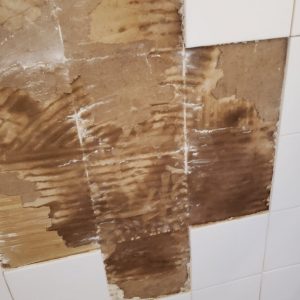Tile shower – Grout replacement turning into something larger…
Hello,
I have a corner shower that has tile on two connected sides, glass on the other two. The leftmost tile side has the shower handle and head. The collar around shower handle was incorrectly sealed and water seeped through down to 1st floor. I believe I caught that before permanent damage. Since I was going to replace the Collar around the handled and seal it, I thought I should replace the grout.
I started off on the wall opposite the entry door without the plumbing. I was using a power grout saw and things were progressing nicely, though dust everywhere, when a tile came off. Probably no surprise to those on this forum. Thankfully it did not break, but then a few others also seemed loose and easily came off the wall. As I peeled these off the wall, I found what I believe to be damp sheetrock. This is very concerning as we have not used this shower for about 1.5 years!! Worth noting, it is an external facing wall and we do not seem to have any leaks.
A number of questions come to mind:
1) Shouldn’t the shower have had some kind of waterproof membrane?
2) Is this indeed moisture, note it is not so soft that I could put my finger through it, but when I touched it, my fingers turned brown.
3) When the tiles came off, they had paper still stuck to them.
Misc things to know:
2nd story
Shower is 28 years old.





















Replies
What's your climate zone? If you're in the south, the moisture drive on exterior walls is often from the outside in. Moisture could be condensing on the back of the impervious tile instead of drying inward as it would in the rest of the house. See this piece from the magazine for a deeper explanation: https://www.finehomebuilding.com/2017/05/10/sunshine-drives-moisture-walls
Back in the day (30-40 years ago) we used green DW for showers. It was accepted back then , and touted as being waterproof. So it really doesn't surprise me the see the DW. But it turned out that it wasn't good for wet environments, and we started using cement board. Or installing Schluter products over the DW. From your description, the installer probably used tile mastic, not thinset, to bed the tiles.
You probably already have this figured out, but you're not going to be able to repair this well. Ripping out the old tile walls and starting over is your best bet. And you can deal with any moisture issues, ( and possible mold from that) if you tear everything out.
I live in the Seattle area and have indeed dug a little further, see attached pictures.
I'm thinking that dark area was a paper covering for the sheetrock, it easier scraped away with a plastic putty knife. It appears there may be a concrete? siding from the floor to about a foot up. The tile is really stuck to that.. Now to figure out how to get the rest of the tile off without damaging too badly the materials underneath.
It's unlikely that there'd be a serious inward moisture drive in Seattle. Maybe there's an exterior leak, or maybe that wall got wet from the shower years ago and never dried. That's a mystery you should solve. In any event, that looks like a gut to the studs job. Some useful info in this video series if you haven't tiled before. https://www.finehomebuilding.com/2012/12/11/video-series-tiling-bathroom-walls